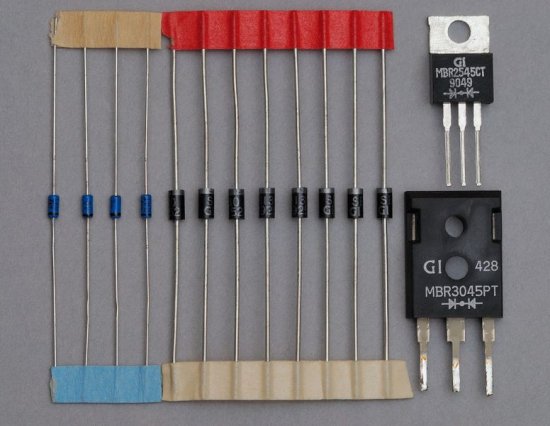What is the difference between a pulse diode and a rectifier
A huge number of modern electronic devices use electrical impulses in their work. These can be low-current signals or current pulses (which are much more serious from a technical point of view) in the circuits of power supplies and other pulse converters, inverters, etc.
And the action of pulses in converters is always critical for the duration of forts and drops, which have time limits approximately in the same order as transients in electronic components, in particular in the same diodes. Therefore, when using diodes in pulse circuits, it is imperative to take into account the transients in the diodes themselves — during their turn-on and turn-off (during the opening and closing of the pn junction).
In general, in order to reduce the switching time of a diode from a non-conducting state to a conducting state and vice versa, in some low-voltage circuits it is advisable to resort to for the use of Schottky diodes.
Diodes of this technology differ from conventional rectifiers by the presence of a metal-semiconductor transition, which, although it has a pronounced rectifying effect, but at the same time has a relatively small transmissive capacity of the transition, the charge in which accumulates in such non-critical quantities and dissolves so fast that the Schottky diode circuit, it can operate at a high enough frequency that the switching time is on the order of a few nanoseconds.
Another plus of Schottky diodes is that the voltage drop across their junction is only about 0.3 volts. So, the main advantage of Schottky diodes is that they do not waste time for the accumulation and resorption of charges, the speed here depends only on the rate of recharging of a small barrier capacitance.
Regarding rectifier diodes, then the original purpose of these components does not imply operation in pulse modes at all. The pulse mode for a rectifier is an atypical, abnormal mode, which is why developers do not impose particularly high requirements on the speed of rectifier diodes.
Rectifier diodes are mainly used to convert low-frequency alternating current to direct or pulsating current, where a small throughput of the pn junction and speed is not required at all, more often just high conductivity and correspondingly high resistance to a relatively long continuous current are required.
Because of this, rectifier diodes feature low on-resistance, a larger p-n junction area, and the ability to pass large currents. But due to the large area of the junction, the capacitance of the diode is higher — on the order of hundreds of picofarads.That's a lot for a pulse diode. By comparison, in Schottky diodes the bandwidth is on the order of tens of picofarads.
So, pulse diodes are specially designed diodes for pulse mode operation in high frequency circuits. Their main distinguishing feature from rectifier diodes is the short duration of the transients due to the very small capacitance of the p-n junction, which can reach units of picofarads and be even smaller.
Reducing the capacitance of the pn junction in pulse diodes is achieved by reducing the junction area. As a result, the dissipated power on the body of the diode should not be very high, the average current through a junction with a small area should not exceed the maximum permissible value, specified in the diode documentation.
Schottky diodes are often used as high-speed diodes, but they rarely have a high reverse voltage, so pulse diodes are isolated as a separate type of diode.

